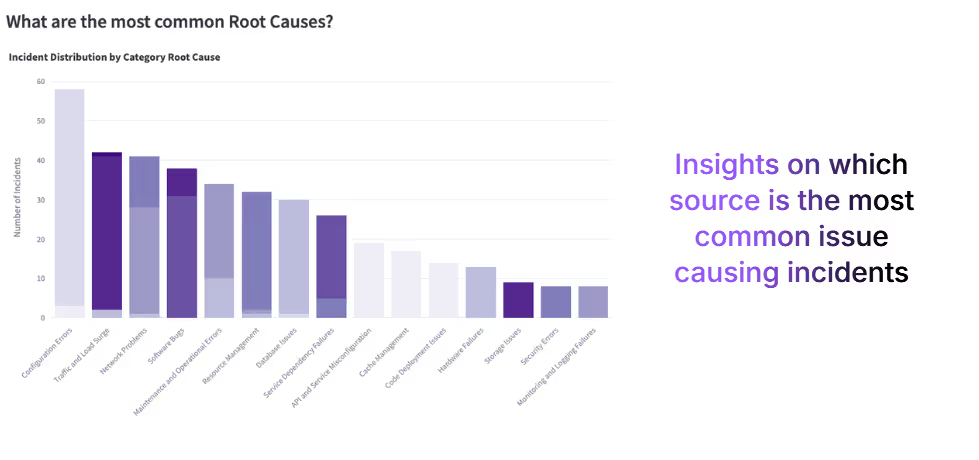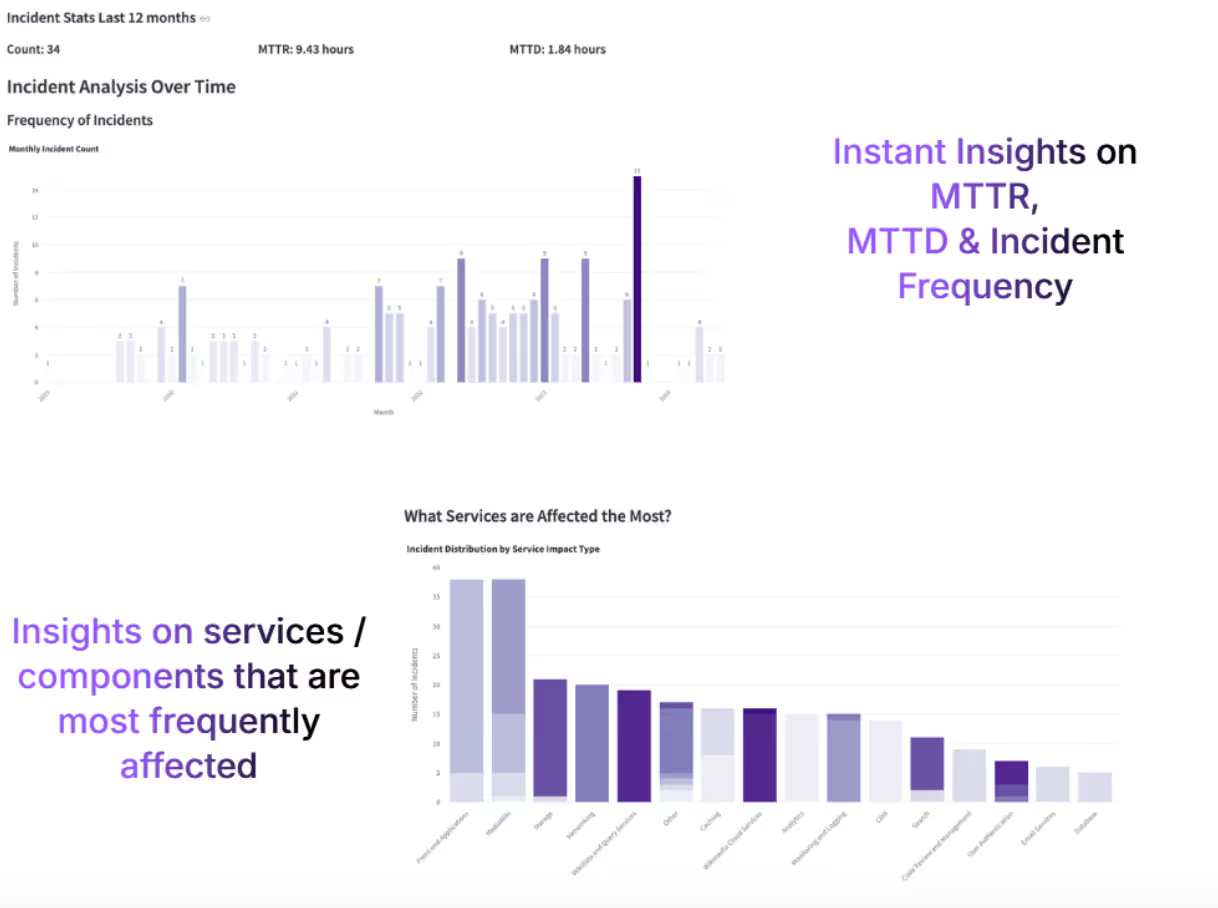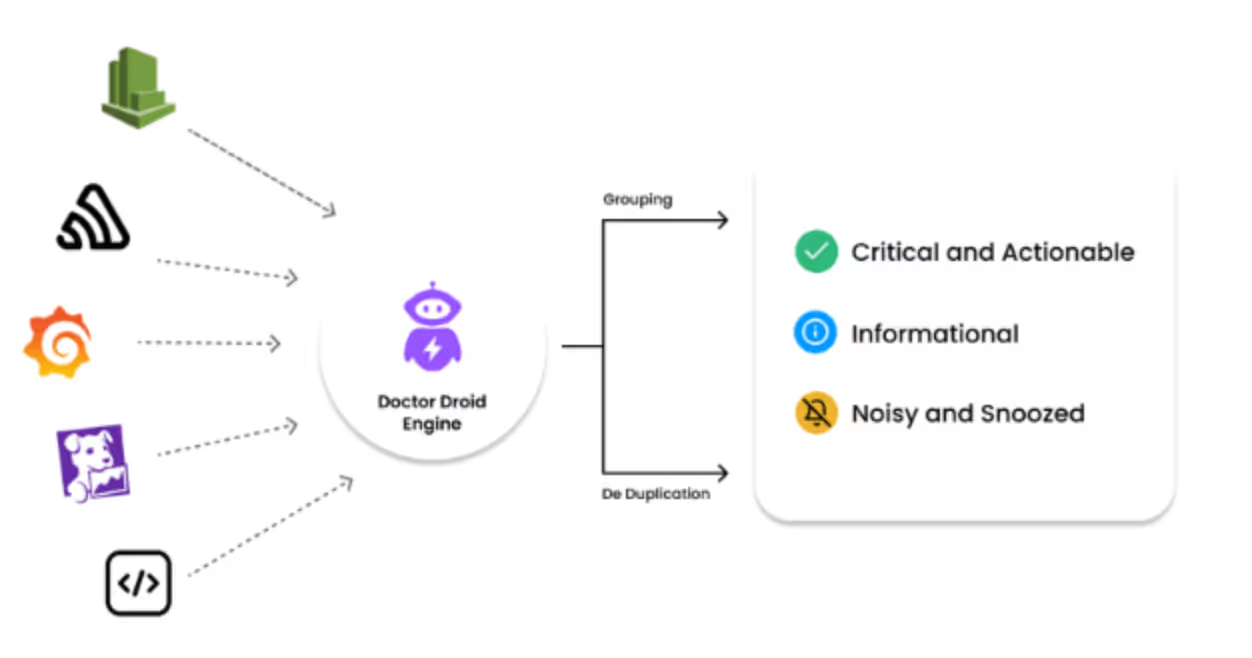On-call investigations are a critical part of ensuring system reliability, but significant challenges often accompany them. Traditional approaches to on-call incident management can be overwhelming, especially when you’re sifting through logs, metrics, and traces to pinpoint the root cause of an issue.
These manual processes are not only time-consuming but also prone to errors, making it difficult to respond to incidents quickly and effectively.
The constant pressure of resolving incidents can lead to burnout and inefficiencies, particularly when working with incomplete or disconnected data. As a result, valuable time is wasted on repetitive tasks instead of focusing on strategic problem-solving.
This is where artificial intelligence (AI) transforms the game for on-call investigations. By automating data collection, analysis, and correlation, AI enables you to cut through the noise and focus on actionable insights.
Instead of spending hours combing through logs, you can rely on AI-powered tools to identify anomalies, suggest resolutions, and even predict potential incidents before they escalate.
In this blog, you’ll explore how AI can streamline your on-call workflows, helping you respond to incidents faster, reduce human error, and improve overall system reliability.
To truly optimize your on-call investigations, it’s essential to understand how AI-driven alert insights transform the way you handle incidents. Let’s take a look at it in the next section.
AI has revolutionized the way you manage and interpret alerts, enabling more efficient incident resolution and minimizing disruptions.
Here’s how AI enhances alert insights across three critical dimensions:
One of the biggest challenges in on-call investigations is the sheer volume of alerts—many of which are redundant or irrelevant. AI-powered tools analyze patterns and contextual data to identify and suppress low-priority or duplicate alerts, allowing you to focus on what truly matters.
Example: Doctor Droid’s alert deduplication system filters out repetitive notifications, reducing noise and ensuring that only actionable alerts reach your team. This minimizes distractions and improves your response time.
To know more about how to get more insights on noisy alerts, click here!
Not all alerts are created equal. AI helps you assign severity levels to alerts by analyzing historical patterns, current context, and potential business impact. This ensures your team knows exactly which incidents require immediate attention and which can wait.
Prioritizing alerts with AI involves a combination of advanced data analysis techniques and contextual understanding.
Here's how it works:
Incidents often span multiple systems, leading to fragmented alerts that can obscure the bigger picture. AI excels at linking related alerts across your infrastructure, helping you uncover broader incidents.
By correlating data from logs, metrics, and traces, AI provides you with a comprehensive understanding of the root cause and enables faster resolution.
Once you’ve tackled alert management, the next step is understanding how AI can simplify one of the most complex aspects of on-call investigations: identifying the root cause of incidents.
Finding the root cause of an incident can often feel like searching for a needle in a haystack. AI-powered tools streamline this process by leveraging advanced techniques to analyze data, identify anomalies, and map dependencies.
Here’s how AI transforms root cause analysis:
Recurring issues are a common culprit in system outages, yet spotting them manually can be a tedious and error-prone process. AI excels at scanning through logs, metrics, and traces to detect recurring patterns, making it easier for you to recognize repeat offenders and address them proactively.
AI goes beyond surface-level monitoring by establishing historical baselines for system performance. When deviations occur—whether in response times, throughput, or resource utilization—AI flags these anomalies in real time; this enables you to catch potential problems early, often before they escalate into critical incidents.
Modern systems are interconnected, and a failure in one component can trigger a cascade of issues across your infrastructure. AI simplifies the process of understanding these relationships by automating dependency mapping. This provides you with a clear visualization of how components interact, helping you pinpoint the source of failures more efficiently.
By automating root cause analysis, you save precious time during high-pressure incidents, reduce human error, and ensure that recurring issues are addressed at their source.

Want to know more about RCA? Read our article, “AI in Automated Root Cause Analysis: Benefits and Use Cases.”
With root cause analysis streamlined, the next frontier is leveraging AI to accelerate incident triage and resolution, empowering you to respond more effectively and proactively.
AI isn’t just about identifying problems—it’s about enabling faster, smarter resolutions. By providing contextual insights and real-time actions, AI revolutionizes how you handle incidents from the moment they occur to their final resolution.
Here’s how it works:
When an incident strikes, knowing where to start can save critical time. AI helps by analyzing the current issue and suggesting relevant runbooks, historical resolutions, or even expert-approved steps based on similar past incidents. This contextual guidance ensures you’re not reinventing the wheel and can act with precision.
AI-powered tools provide instant insights into the most impacted services, root causes, or areas needing immediate attention.
For instance, Doctor Droid can surface key information about the top affected components and highlight potential fixes in seconds, enabling you to address the issue without delays.
The real power of AI lies in its ability to look ahead. By continuously monitoring your systems and analyzing trends, AI can predict potential issues before they escalate. This allows you to initiate proactive investigations and implement fixes preemptively, reducing downtime and ensuring smoother operations.
By integrating AI into your incident triage and resolution processes, you not only improve your response times but also enhance overall system reliability. AI helps you stay ahead of the curve, turning reactive firefighting into proactive problem-solving.
Effective on-call investigations require seamless collaboration, and AI can play a pivotal role in ensuring your team stays aligned and informed throughout the incident resolution process.
Collaboration is the backbone of efficient incident management. With AI, you can enhance team coordination and streamline communication, even during high-pressure situations.
Here’s how AI empowers collaboration during on-call investigations:
AI integrates seamlessly with popular collaboration tools like Slack and Microsoft Teams, centralizing communication and making it easier for teams to stay connected. AI-driven alerts and insights are shared directly within these platforms, ensuring that everyone involved has access to the same critical information in real-time.
Manually creating incident summaries can be time-consuming, especially when you’re juggling multiple tasks during an investigation. AI eliminates this burden by auto-generating detailed incident reports that capture key details, actions taken, and the timeline of events.
Example: Doctor Droid’s incident summary feature provides concise yet comprehensive reports, simplifying post-mortem reviews and ensuring actionable learnings for the future.


AI dynamically updates the status of incidents based on ongoing investigation progress. This ensures that all stakeholders—whether they’re on the investigation team or part of leadership—remain informed of the latest developments without needing constant manual updates.
By leveraging AI for collaboration, you ensure better communication, faster decision-making, and a more cohesive response during on-call investigations. It’s not just about resolving incidents; it’s about doing so as a unified and efficient team.
To fully harness the power of AI, it’s essential to integrate it with the tools you already rely on for monitoring, incident management, and log analysis.
AI’s transformative capabilities reach their full potential when combined with the platforms you use daily. By integrating AI with your existing tools, you can enhance their efficiency, streamline workflows, and maximize the value of your technology stack.
Tools like Prometheus, Datadog, and AWS CloudWatch are cornerstones of your monitoring strategy. AI integration enhances these platforms by providing advanced anomaly detection, predictive alerts, and noise reduction.
Instead of drowning in a sea of alerts, AI helps you focus on the most critical issues, offering actionable insights to guide your response.
Example: Doctor Droid seamlessly integrates with these monitoring tools to reduce alert noise in real-time. By analyzing historical patterns and contextual data, Doctor Droid suppresses redundant or low-priority alerts while highlighting critical ones.
For instance, during a sudden spike in application errors, Doctor Droid identifies and surfaces the root cause alert—such as a failing database connection—while suppressing related secondary alerts, ensuring your team can act decisively.

Doctor Droid plugs into PagerDuty, OpsGenie, Slack, and your monitoring stack to automate the grind and surface what matters.
Its smart escalation engine learns from previous incidents, routing every new alert to the right engineer—and their backup—before the pager even vibrates.
The moment an alert fires, Doctor Droid attaches a context-aware runbook to the incident card—restart pods, scale a deployment, clear a cache—so you never have to rummage through wikis.
When the conditions match, the platform goes hands-free: it executes the runbook, posts results to Slack, and reopens the ticket only if human review is still needed.
Ready to see it live? Explore Doctor Droid—or jump straight to the demo video and watch a noisy alert collapse into a fully resolved incident in under two minutes.
Log analysis and Application Performance Management (APM) tools like Splunk, Elasticsearch, and New Relic are essential for diagnosing and resolving incidents.
AI takes these tools to the next level by identifying patterns in massive datasets, correlating log entries across systems, and predicting potential failures. This deeper insight helps you troubleshoot faster and more accurately.
Also, Read our articles “Mastering New Relic Alerts: Key Terminologies” and “Guide for New Relic Alerting.”
By integrating AI with these platforms, you create a unified ecosystem where tools work smarter together. This not only simplifies your on-call processes but also amplifies the effectiveness of your existing investments in monitoring and incident management technologies.
To fully unlock the potential of AI in on-call investigations, it’s essential to follow best practices that ensure smooth adoption and optimal results.
Integrating AI into your on-call workflows is a game-changer, but it requires a thoughtful approach to maximize its impact.
Here are some best practices to help you get the most out of AI for incident management:
When introducing AI, start with a focused approach. Test AI features on critical alerts or specific components of your stack before scaling them across your entire infrastructure. This allows you to evaluate the effectiveness of AI tools and make necessary adjustments in a controlled environment.
AI insights are only valuable if they’re transparent and actionable. Prioritize tools that provide clear explanations for their recommendations, helping you understand the reasoning behind suggested actions. This ensures trust in the system and equips your team to make informed decisions quickly.
AI models need to stay updated to remain effective. Make it a practice to regularly train your models using the latest data from your systems. This improves their accuracy in detecting anomalies, predicting incidents, and providing actionable insights over time.
AI is a powerful assistant, but it’s not a substitute for human judgment—especially during complex incidents. Use AI to augment your team’s capabilities by automating repetitive tasks and surfacing insights, allowing engineers to focus on higher-level problem-solving and decision-making.
By following these best practices, you can integrate AI into your on-call investigations confidently and effectively. It’s about finding the right balance between leveraging automation and retaining the critical human element that drives successful incident management.
To bring these concepts to life, let’s explore real-world examples of how AI enhances on-call investigations and solves common challenges effectively.
AI’s impact on on-call workflows is best illustrated through practical scenarios. Here are three examples where AI significantly improved incident detection, triage, and resolution:
In complex microservices architectures, tracing the root cause of an issue can feel like navigating a maze. AI tools excel at dependency mapping, which helps you quickly identify how one failing service impacts others.
For instance, when a team experienced high latency in their user-facing API, AI mapped the interactions across microservices and pinpointed the source—a misconfigured database connection. This enabled the team to resolve the issue rapidly, minimizing downtime.
Alert fatigue can overwhelm your team, especially during known incidents such as deployments.
During a spike in errors caused by a planned deployment, Doctor Droid suppressed duplicate alerts related to the same issue, drastically reducing noise. This allowed engineers to focus on validating the deployment’s success instead of being distracted by redundant notifications.
AI’s ability to predict issues before they escalate is a game-changer. In one instance, AI detected an unusual upward trend in CPU utilization across a production server. By flagging the anomaly early, the team was able to optimize resource allocation and prevent the spike from impacting users. This proactive approach not only improved reliability but also saved the team from a potential on-call emergency.
These examples highlight how AI transforms on-call investigations, helping you address challenges with greater speed, accuracy, and confidence.

AI-first AIOps is reshaping life on call—from endless paging to quiet, data-driven resilience. Doctor Droid puts that shift at your fingertips.
The result: fewer pings, faster fixes, and engineers who sleep—and ship—better.
Ready to see it in action? Explore Doctor Droid’s AI investigations and runbooks at drdroid.io.
Try Doctor Droid — your AI SRE that auto-triages alerts, debugs issues, and finds the root cause for you.
(Perfect for DevOps & SREs)

Install our free slack app for AI investigation that reduce alert noise - ship with fewer 2 AM pings
Everything you need to know about Doctor Droid
The main benefits include faster root cause analysis, reduced alert noise, improved collaboration between team members, more effective incident triage, and the ability to implement proactive monitoring. AI helps make incident management more efficient and less stressful for on-call engineers and SREs.
AI can significantly reduce alert fatigue by filtering out noise, correlating related alerts, prioritizing issues based on severity, and providing context for each alert. This helps on-call engineers focus on what truly matters instead of wading through numerous notifications.
AI accelerates incident triage by automatically analyzing logs and metrics, identifying potential root causes, suggesting resolution steps based on historical data, and providing relevant documentation. This speeds up the time-to-resolution and reduces the cognitive load on engineers during incidents.
AI enhances collaboration by summarizing incident details for team members joining mid-incident, maintaining context across shift handovers, facilitating knowledge sharing, and ensuring consistent communication across various platforms. This creates a more streamlined response process with fewer miscommunications.
Yes, most AI solutions for on-call work are designed to integrate with popular monitoring platforms, ticketing systems, chat applications, and observability tools. The best AI solutions enhance your existing toolchain rather than requiring you to replace it.
Best practices include starting small with specific use cases, providing quality training data, maintaining human oversight, gathering feedback from users, establishing clear expectations, and continuously improving the AI models based on actual incident data.
No, AI is designed to augment human capabilities, not replace them. The goal is to handle routine tasks, provide insights, and suggest solutions, while engineers maintain final decision-making authority and handle complex situations that require human judgment.
Doctor Droid is a platform specifically designed for SREs and on-call engineers that integrates AI into incident response workflows. It offers features like noise reduction, actionable recommendations, and automated post-incident playbooks to help resolve incidents faster and more efficiently.
Dr. Droid can be self-hosted or run in our secure cloud setup. We are very conscious of the security aspects of the platform. Read more about security & privacy in our platform here.
Dr. Droid can be self-hosted or run in our secure cloud setup. We are very conscious of the security aspects of the platform. Read more about security & privacy in our platform here.


